There’s something familiar about unboxing an Apple device—the subtle click of the box, the smooth feel of aluminum, the instant pairing sound of AirPods. It’s a process so refined that it almost feels personal. But beyond the clean design and glowing logo, a bigger question remains: is Apple just about aesthetics, or is there more beneath the surface?
Apple has built more than just products—it’s shaped an entire digital environment. One where your phone, laptop, watch, and headphones don’t just coexist, but work together seamlessly. This experience depends not only on hardware, but on the strength of your internet connection, the reliability of cloud syncing, and the ease of ongoing support.
This piece looks beyond the branding to understand how Apple fits into modern connected life—how it delivers performance, integration, and support that quietly powers the everyday.
Everyday Devices That Anchor Our Digital Lives

Before diving into specs, it’s worth seeing what Apple does best—creating smooth, consistent experiences. These devices aren’t just tools; they quietly integrate into daily life, especially when backed by strong broadband.
Want to see how Apple’s approach compares to other top tech brands in 2025? Explore the race for tech supremacy and find out who’s really leading.
iPhone – The All-Day, Every-Day Essential
The iPhone is at the center of most digital routines. Models like the iPhone 15 and SE offer 5G support, FaceTime in high definition, and a battery that can stretch across the day. But what really makes it dependable is how well it works over broadband—quick syncing, instant messaging, and always-on cloud access.
- iCloud Photos – Backs up your media in real time, no manual uploads needed.
- iMessage – Sends texts, videos, and voice messages instantly over Wi-Fi.
- App Store & Updates – Smooth downloads and software installs with strong internet.
Every feature benefits from solid internet. It’s fast, yes—but it’s also predictable.
MacBook and iMac – High-Speed Productivity Machines
MacBooks and iMacs powered by Apple’s M2 and M3 chips are made for focused, high-performance work. With instant boot times and energy-efficient multitasking, they’re perfect for remote teams, creative professionals, and students. Paired with fast internet, cloud drives, video calls, and browser-heavy tasks run effortlessly—all while staying cool and quiet.
iPad and Apple Pencil – Work, Play, Create Anywhere
iPads offer unmatched flexibility. Whether used for sketching, remote learning, or editing content, they’re responsive and portable. The Apple Pencil adds precision, while Wi-Fi or cellular keeps files syncing and apps updated no matter where you are. From couch to classroom, the iPad adapts quickly and reliably.
Apple Watch & AirPods – Personal Tech That Feels Invisible
The Apple Watch and AirPods feel like silent assistants. They pair instantly, track your movement, manage calls, and stream audio—all while staying quietly in sync. On stable broadband, updates are quick, audio stays crisp, and your data moves between devices without interruption. They’re subtle, efficient, and always connected—just like the rest of Apple’s lineup.
Need help choosing a smartwatch that fits into your Apple routine or lifestyle? Take a look at our guide to finding the right smartwatch for you.
Designed for a Broadband-First World

Apple’s ecosystem thrives on fast, reliable internet. From real-time syncing to smooth streaming, its devices are built to take full advantage of strong broadband. Connectivity isn’t an extra—it’s central to how Apple ensures every update, app, and interaction feels instant and effortless.
Wi-Fi 6E & 5G Integration
Apple’s latest devices are built with next-generation connectivity in mind. With Wi-Fi 6E and 5G support, iPhones, iPads, and Macs can shift to the fastest available signal without user input. That means fewer dropped calls, clearer FaceTime chats, and smoother syncing—even in crowded network environments. This integration also ensures that large software updates and app downloads complete in the background, without slowing down your work or draining your battery.
iCloud as the Always-On Hub
More than just storage, iCloud quietly powers the Apple ecosystem behind the scenes. When your broadband is strong, iCloud works effortlessly—syncing photos, documents, notes, and backups in real time. It’s not something most users think about, but it’s one of Apple’s most powerful features when supported by fast, reliable Wi-Fi.
- Photo and file backup happens continuously without slowing down device performance.
- Notes, reminders, and calendar events stay synced across all devices.
- Device switching and restores feel almost instant when your data is always current in the cloud.
With stable internet, iCloud becomes the brain of your Apple life—one that’s always up to date without ever asking for attention.
AirDrop, Handoff, and Sidecar
These features define how Apple devices communicate with each other—and with you. AirDrop lets you send a file across devices with one tap. Handoff allows you to move seamlessly from iPhone to Mac or iPad without losing your place. Sidecar transforms your iPad into an instant second screen. All of these work best over strong broadband or a stable local Wi-Fi network. When that connection is in place, productivity feels fluid, almost automatic.
The Apple Ecosystem—Elegant, Efficient, and a Little Exclusive

Connectivity feels seamless when every device speaks the same language—and that’s where Apple stands out. Its ecosystem isn’t just about having multiple products, but how naturally they sync and share through broadband. It’s smooth, simple, and smart—though not without a few limits.
One ID, Multiple Devices, No Confusion
At the heart of Apple’s ecosystem is a single Apple ID. This login isn’t just your App Store password—it connects iCloud, Messages, FaceTime, and more across all your devices. Once signed in, everything stays synced without extra setup.
- Calendars and reminders update instantly across your iPhone, Mac, and iPad.
- Passwords and Safari tabs are shared securely through iCloud Keychain.
- Files and photos are backed up and available no matter which device you’re using.
This kind of consistency is rare—and it’s what makes Apple feel effortless.
From Mac to iPhone to TV with One Tap
Apple’s cross-device features are designed to be invisible but powerful. You can copy text on your Mac and paste it on your iPhone using Universal Clipboard. AirPlay lets you mirror screens or stream audio to an Apple TV in seconds. Even something as simple as unlocking your Mac with your Apple Watch feels intuitive.
With a strong Wi-Fi or Ethernet connection, these transitions are instant, letting you move between devices without friction.
Where the Walled Garden Gets in the Way
Of course, this tight integration comes at a cost. Apple controls how its devices interact with the outside world. You can’t change default apps easily, and you’re often steered toward iCloud instead of other cloud services. File sharing with non-Apple users isn’t always smooth, and third-party workarounds can feel clunky.
The ecosystem works beautifully—so long as you stay inside it.
Longevity, Resale, and Software Support
Apple devices often cost more upfront, but that investment usually goes further. With long-term software support, solid build quality, and strong resale value, Apple products are designed to last. For those who keep their devices for years or pass them down, the value holds up over time.
Curious how smartphone cameras stack up for everyday photo use? Check out what makes a smartphone camera worth your attention.
Years of OS Updates—Even on Older Devices
One of Apple’s biggest strengths is its consistent software support. iPhones, iPads, and Macs often receive major updates for five years or more. Even older models continue to benefit from security patches and new features long after release. This means your device stays secure, performs well, and feels current—even if you skip a generation or two.
Devices That Hold Value
Apple products tend to age gracefully—not just in performance, but in resale value. Whether you’re selling an old iPad or trading in a MacBook, you’ll typically get a higher return than with other brands.
- MacBooks and iPhones retain resale value longer due to build quality and OS support.
- Apple’s trade-in program offers instant credit or store value with minimal hassle.
- Even older devices often find a second life through resale markets or family use.
For those planning upgrades, this helps ease the cost of staying in the ecosystem.
Sustainable Use Through Durability
Apple’s build quality contributes to more sustainable tech use. Devices are made with durable materials like aluminum and ceramic shield glass, which reduce the need for frequent replacements. Some models now include repair-friendly designs and recycled components, reflecting Apple’s push toward sustainability.
By designing products to last longer and age slower, Apple encourages fewer upgrades—and smarter ones.
Conclusion
Apple isn’t just a logo—it’s a digital lifestyle built around connection, simplicity, and consistency. Every device, from iPhone to Mac, is designed to work together quietly and intuitively, especially when supported by strong broadband. It’s a system that feels effortless because every detail, from syncing to support, is carefully thought through.
This approach shines when your world is always online and always in sync. But it’s not without limits. For those who prefer more customization, open platforms, or tighter budgets, Apple’s tight-knit ecosystem might feel a bit too controlled.
Still, its strength lies in removing friction from the digital experience.




